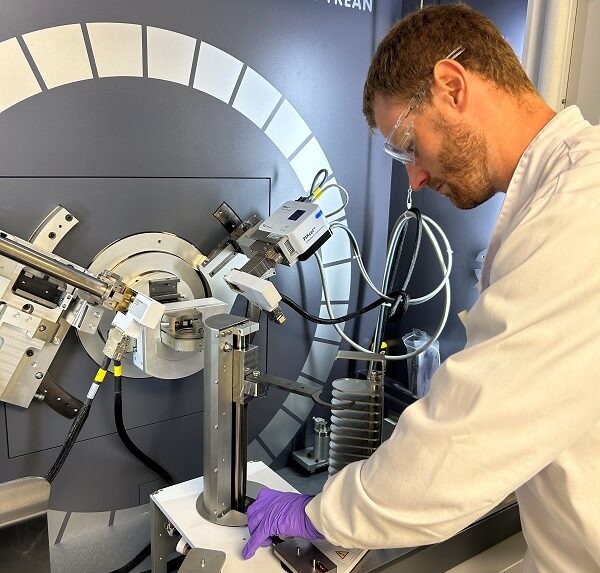In recent years APIs have become increasingly more complex to address the needs of an ever-changing pharmaceutical market. This includes not only small molecules with complex scaffolds and often containing multiple chiral centers, but also new modalities such as proteolysis targeting chimeras (PROTACs) and antibody-drug conjugates (ADCs). PROTACs, a class of Targeted Protein Degarders (TPDs), are heterobifunctional molecules consisting of two ligands connected via a flexible linker. They have the ability to target hard-to-drug proteins to treat diseases like cancer, diabetes and Alzheimer’s.
ADCs are a class of biopharmaceutical drugs that can act as targeted therapy for cancer, treating the disease without the often-devastating side effects of traditional chemotherapy. However, increased complexity often leads to associated developability challenges, e.g., high potency handling, low solubility and often difficult-to-crystallize molecules. This only further necessitates the need for early-stage physical characterization and subsequent screening to develop a rigorous understanding of the solid form landscape of an API.
Understanding the impact of solid form in drug products
Physical and chemical challenges can arise throughout all stages of drug development, leading to delays in bringing drugs to patients. These issues are increasingly difficult to address as development progresses. Developers often encounter low solubility and poor bioavailability. Stability issues, formulation problems and lack of process control – including chirality, polymorphic form changes and issues with scale-up – can further complicate the development process and directly impact patients.
A clear example of this are the issues experienced with Ritonavir in the 90s. Ritonavir was developed by Abbot for the treatment of HIV. Ritonavir gained FDA approval in 1996 and was administered, as a semi solid capsule formulation (Norvir) containing a solution of the API. However, early in 1998 (2) product lots began to fail dissolution testing with drug substance precipitation observed. This precipitant was a new polymorph, Form 2, that was thermodynamically more stable and less than half as soluble in the formulation media as the known Form 1. Additionally in the presence of Form 2 seeds, it was no longer possible to produce Form 1, “a disappearing polymorph”, seriously impacting patient supply. Despite efforts to recover Form 1, Abbot had no choice but to pull the drug from the market losing an estimated $250M.
The Thalidomide tragedy also serves as a clear reminder of the importance of process control and characterization in drug development. Thalidomide was given to pregnant people in the 1950s-60s to relieve morning sickness. The compound can exist as two mirror images (chirality) with the R-enantiomer of Thalidomide as the bioactive form. However, within the body, the R-enantiomer can undergo in vivo chiral inversion (it can flip inside the body) to form the S-enantiomer. Even though enantiomeric pairs look almost identical, they can have catastrophically different biological actions. The S-enantiomer causes birth defects in the fetus, resulting in thousands of children born with limb differences and many infant deaths.
These examples highlight the dire consequences of overlooking the importance of solid form changes, chiral control, etc on drug efficacy and patient safety. By utilizing solid form analysis, screening and selection techniques early on, potential U-turns and issues can be avoided, ultimately saving time and resources. (3)
Solid form identification and selection
Choosing the most suitable solid form of a compound is crucial in saving time and resources during drug development. This process, known as solid form selection, is essential as crystalline forms display different solid form and physicochemical properties. Selection of the wrong solid form will impact the success of the chosen compound as a drug candidate. The free form of APIs often presents poor physicochemical properties as discussed above. Formation of crystalline salts and cocrystals with pharmaceutically acceptable counterions and coformers can often address solubility challenges. In all instances, whether you are developing the free form, a salt or a cocrystal, a comprehensive understanding of the polymorphic landscape must be obtained. Rigorous screening, polymorph, salt and cocrystal, coupled with state-of-the-art characterization, are essential for identifying and understanding the solid forms of a compound and selecting the candidate with the best solid form properties for further development.
Currently > 50 % of commonly used drug molecules are chiral (4). As illustrated in the Thalidamide example above, chiral confirmation and control must be demonstrated to ensure the efficacy and safety of these drug molecules. Solid form also plays a vital role here. Chiral resolution can be used to identify a scalable method for chiral control of the desired enantiomer. Furthermore, complimentary analysis by Single Crystal X-ray diffraction can confirm the absolute stereochemistry of this enantiomer in alignment with regulatory standards (e.g., FDA).
Particle engineering solutions
Once a suitable solid form of an API is selected, the next step is to fine-tune the candidate making sure it is suitable for patient administration. Pharmaceutical particle engineering ensures that the form of interest can be reproducibly made at scale, for use in the intended therapeutic area in the selected dosage form.
For crystalline materials, this involves identifying a scalable crystallization process for obtaining the compound in the desired form with high purity, yield and to a defined particle size and morphology that is suitable for the route of administration. If this cannot be obtained directly from crystallization, traditional particle engineering techniques such as milling, a ‘top-down’ procedure, can be utilized to further reduce and control particle size.
In general, crystalline forms are preferred for drug development for a number of reasons including physical and chemical stability. However, in some instances crystalline material cannot be obtained or may have solubility/bioavailability that prohibits development even in the salt form. Amorphous solids, which lack long-range order, exhibit increased solubility due to their lower energy barriers but face stability issues compared to crystalline solids. (5) Developers are now using advanced particle engineering technologies such as hot melt extrusion and spray drying, known as ‘bottom-up’ techniques, to allow for better stability control of amorphous solids. Furthermore, amorphous solid dispersion screening can identify suitable dispersions that address inherent stability issues of the “naked” amorphous API itself. This enables developers to harness the superior solubility of amorphous solids, while also ensuring stability and allowing a larger range of compounds to be passed through solid form analysis that may have otherwise caused challenges in later development.
Handling complexity with confidence
As the trend toward more personalized or targeted pharmaceuticals continues to emerge, solid form science will play a crucial role in ensuring that these increasingly complex and insoluble APIs successfully reach the market. It is vital to fully understand the compound before continuing to scale up, both for monetary cost and patient safety. Understanding the value of particle engineering is also a key measure of success within the development sphere and something that can greatly decrease roadblocks at later stages.
Assessing and modifying solid form to ensure APIs are ready for patient administration requires a vast range of techniques and expertise. Focused and agile CDMOs, such as Veranova, are paving the way in this area. Veranova provides comprehensive crystal and particle engineering solutions to address challenges in early development, optimizing API performance and bioavailability for patients. With the Pharmorphix brand having celebrated its 20-year anniversary in 2023, Veranova has access to a legacy of world-class solid form offerings. Look out for future Expert Insights articles to find out more about how Veranova leverages expertise in solid form analysis and particle engineering to achieve successful scale-up and delivery, de-risking drug development, expediting clinical trials, and improving patient outcomes.
References
1 – Manikandan, P. & Subramanian, N., Improving Solubility and Bioavailability of Poorly Water-Soluble Drugs by Solid Dispersion Technique – A Review, Int. J. Pharm. Sci. Rev. Res., 2013, 23(1), 220-227
2 – Bauer, J.; Spanton, S.; Henry, R.; Quick, J.; Dziki, W.; Porter, W; Morris, Ritonavir: An Extraordinary Example of Conformational Polymorphism J. Pharm. Res. 2001, 18, 859–866.
3- Tokunaga, E.; Yamamoto, T.; Ito, E. et al. Understanding the Thalidomide Chirality in Biological Processes by the Self-disproportionation of Enantiomers. Sci. Rep., 2018, 8, 17131.
4- Singh, M.; Sethi, S.; Bhushan, R. Liquid chromatographic methods for separation, determination, and bioassay of enantiomers of etodolac: A review. J. Sep. Sci. 2019, 43, 18–30.
5 – Gurunath, S.; Kumar, S. P.; Basavaraj, N. K.; Patil, P. A. Amorphous Solid Dispersion Method for Improving Oral Bioavailability of Poorly Water-soluble Drugs. J. Pharm. Res. 2013, 6(4), 476-480.

 Suzanne Buttar, Ph.D., BSc(Hons), is a Director in the Pharmorphix team, at Veranova’s Centre of Excellence for Solid Form and Particle Engineering (SFPE) in Cambridge, UK. Suzanne received her doctorate from the University of Glasgow in small molecule crystallography and subsequently joined the Pharmorphix team in 2007. Suzanne started as a project scientist in the lab, working on a broad range of SFPE projects. Owing to her crystallography background, she also led the onsite Single Crystal Team for several years.
Suzanne Buttar, Ph.D., BSc(Hons), is a Director in the Pharmorphix team, at Veranova’s Centre of Excellence for Solid Form and Particle Engineering (SFPE) in Cambridge, UK. Suzanne received her doctorate from the University of Glasgow in small molecule crystallography and subsequently joined the Pharmorphix team in 2007. Suzanne started as a project scientist in the lab, working on a broad range of SFPE projects. Owing to her crystallography background, she also led the onsite Single Crystal Team for several years.